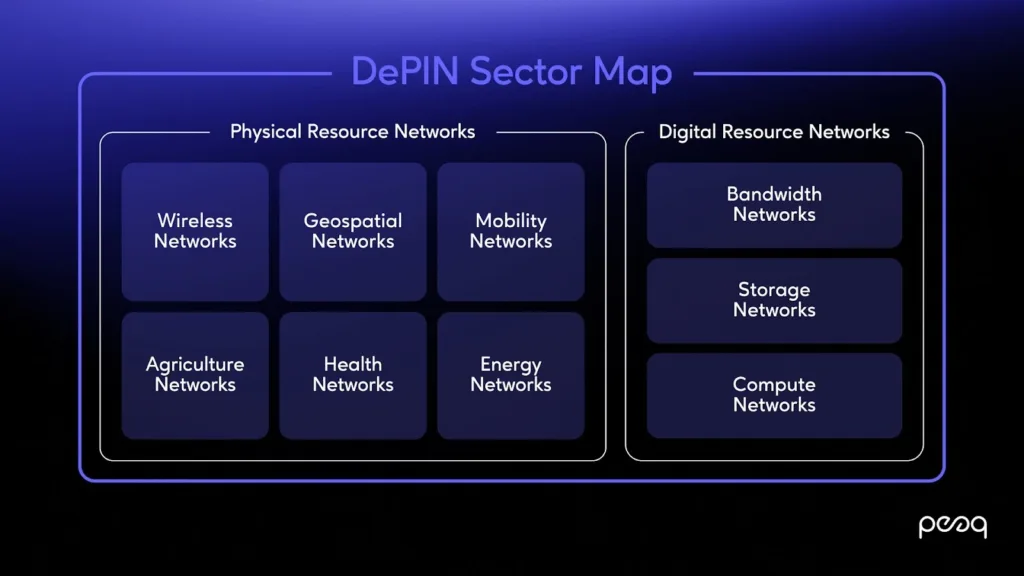Blockchain technology has revolutionized various industries, from finance to supply chain management. However, its potential extends beyond the digital realm. Decentralized Physical Infrastructure Networks (DePINs) are emerging as a groundbreaking concept that brings physical infrastructure to the blockchain. By leveraging blockchain technology and crypto incentives, DePINs aim to reshape how we build and manage physical infrastructure. In this article, we will delve into the fundamentals of DePINs, their value proposition, and the potential they hold for the future, particularly in the context of decentralized finance and Web3 innovations. DePIN cryptos are the underdog of current era in the web3 world.
Understanding DePINs
What are DePINs?
Decentralized Physical Infrastructure Networks, or DePINs, harness the power of blockchain and Web3 to coordinate and incentivize the crowd-sourcing phase of infrastructure projects. These projects deliver tangible, real-world services and value, all while operating seamlessly on a decentralized network in the background. DePINs are poised to disrupt traditional infrastructure building and maintenance methods by offering a more efficient and cost-effective alternative, with token rewards fueling their innovative business model.
The Role of Corporations and Volunteers
Corporations that typically invest significant time, energy, and money into building and maintaining physical infrastructures, such as telecommunications companies, can participate in DePINs. Instead of constructing infrastructure from scratch, these legacy companies can trade the physical constructs they would need to build with volunteers who act as nodes in the network. In return for integrating their hardware under the service of these companies, volunteers are rewarded with tokens through well-designed reward mechanisms, which can be cashed out once the company kickstarts and its tokens increase in value. This business model mirrors the value proposition of cloud companies like Uber and Airbnb, enabling entrepreneurs to launch their businesses without the need for extensive hardware or infrastructure.
Advantages of DePINs
DePINs offer several advantages over traditional approaches to physical infrastructure:
- AffordabilityDePINs provide a significantly more affordable option than traditional methods, offering sustainable and resilient infrastructure solutions. By eliminating the cost of constructing physical constructs and the personnel required for maintenance, DePINs present a cost-effective solution that aligns with the goals of sustainable development.
- Flexibility and ScalabilityDePINs allow for horizontal scalability, enabling networks to increase resources instead of the capacity of each resource. This flexibility allows for easy scaling in and out depending on demand, making DePINs highly adaptable to rapidly changing market needs and solidifying their position as a scalable solution within decentralized networks.
- Community ControlDePINs decentralize control of resources, distributing it among the network participants. This collective ownership model ensures a more resilient network and promotes equal opportunity and fairness, embodying the principles of decentralized control and decentralized ownership.
- SpeedLinking existing hardware into a network is much faster than building individual constructs in specific locations. DePINs significantly reduce the time needed to launch a company, providing a competitive advantage in the market and enabling rapid deployment of new services.
- ResilienceWith thousands of nodes providing resilient infrastructure, DePINs are fortified with enhanced security and are more resistant to attacks and technical issues like outages. The distributed nature of DePINs fosters a neutral and collectively-owned network that stands as a paragon of resilience.
Emerging Players in the DePIN Space

While DePINs are still emerging in the crypto news, several DePIN projects are making significant strides in this innovative field. Let’s delve into some of the notable initiatives that are shaping the future of decentralized networks.
- Fleek : Fleek is on a mission to become an open-source hub in the Web3 space, where companies can innovate and grow their businesses atop the DePIN concept. By harnessing the power of blockchain technology and a decentralized framework akin to cloudflare web3, Fleek positions itself as a decentralized alternative to conventional cloud services, boasting enhanced performance and scalability.
- Bosch XDK110 Rapid Prototyping Kit : A groundbreaking collaboration between Bosch, Fetch.ai, and Peaq is underway to forge a multi-chain Internet of things network, leveraging DePIN principles for real-world applications. This alliance is integrating IoT sensors, AI, and blockchain to foster interoperability and enable the crowd-sourcing of physical infrastructure across diverse sectors.
These trailblazing entities are carving a path for the decentralized ecosystem to flourish, demonstrating the innovation in infrastructure that DePINs bring to the table. Their efforts are instrumental in propelling the widespread adoption of DePINs and revealing the immense potential of this cutting-edge approach.
Use Cases of DePINs

DePINs boast a vast scope with cross-industry applications that extend across numerous industries and sectors. Here are some compelling use cases for DePINs that highlight their versatility and broad applicability.
1. Energy Grids
DePINs have the potential to revolutionize peer-to-peer energy trading within decentralized energy grids, connecting small-scale solar energy producers in a blockchain network. This innovative system allows for the efficient distribution and sharing of energy among participants, fostering renewable energy adoption and diminishing the dependency on centralized energy suppliers.
2. Wireless Connectivity
Decentralized wireless networks, facilitated by DePINs, can significantly enhance the creation of community-driven internet connectivity. This innovative approach not only promises improved connectivity in regions that are currently underserved but also poses a competitive alternative to conventional internet service providers.
3. Transportation
In the transportation industry, DePINs have the potential to disrupt traditional models by introducing decentralized car-sharing services and commercial delivery networks. These crowd-sourced transportation solutions can lead to more efficient, cost-effective, and eco-friendly options for consumers and businesses alike.
4. Geographical Services
Leveraging user participation, DePINs can forge decentralized mapping services that harness geographical data from individuals using their smartphones. This collaborative effort enables the creation of a detailed and constantly updated mapping platform, offering a formidable challenge to established centralized services.
The examples provided are merely a glimpse into the array of innovative use cases DePINs can offer. As this technology progresses and becomes more widely recognized, we can anticipate a surge of novel industry applications that will transform how we interact with various sectors.
Challenges and Future Outlook
Despite the potential of DePINs to revolutionize multiple sectors, they confront significant challenges and barriers to adoption that must be addressed. Identifying and overcoming these obstacles is paramount to enable the widespread acceptance and success of DePIN initiatives.
- Regulatory ComplianceDePINs, particularly in regulated sectors such as energy and transportation, may encounter stringent regulatory hurdles. Navigating these sector-specific regulations is a critical step that must be taken to ensure the viability and advancement of DePIN projects.
- ScalabilityAs DePIN networks expand, they face scalability challenges that must be met to maintain efficiency. It’s crucial for the underlying infrastructure to meet the increasing demand and ensure robust performance, which is vital for the enduring success of DePINs.
- User AdoptionEducating users about the benefits and potential of DePINs is essential for overcoming adoption barriers. It’s crucial to address the inertia of established centralized systems and persuade users to embrace decentralized alternatives as a significant challenge.
Despite these challenges, the future outlook for DePINs is optimistic, with expectations of increased innovation and adoption. As the landscape evolves, we can anticipate a surge in groundbreaking projects that will enhance scalability and further cement the promising prospects of DePINs.
Conclusion
Decentralized Physical Infrastructure Networks (DePINs) signify a transformative shift in constructing and managing physical infrastructure. By harnessing blockchain technology and crypto incentives, DePINs introduce a community-driven approach that stands in contrast to conventional methods. They promise affordability, flexibility, and community control, setting the stage for a revolution in sectors such as energy, transportation, and wireless networks. While hurdles are present, the trajectory for DePINs is filled with potential for continued innovation and adoption. As DePINs increasingly merge physical infrastructure with blockchain capabilities, they are on course to redefine our engagement with the tangible world around us.
Disclaimer: The information provided in this article is for informational purposes only and should not be considered financial or investment advice. The author is not affiliated with any entities mentioned in the article. Please do your own research before engaging in any cryptocurrency-related activities. Hash Herald is not responsible for any loss in the market













